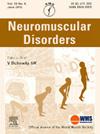278P Mapping human skeletal muscle enhancers to increase rates of genetic diagnosis
IF 2.8
4区 医学
Q2 CLINICAL NEUROLOGY
引用次数: 0
Abstract
Despite the identification of almost 600 disease genes for neuromuscular disorders, only 30-50% of affected individuals receive a genetic diagnosis following diagnostic screening via targeted gene panels or clinical exomes. For a subset of those patients who do not receive a genetic diagnosis, the disease causing variant may be located in the 98% of the human genome that is non-coding. Approximately 20-40% of the non-coding genome has a regulatory function, dictating when in development, in which tissues, and at what level our coding genes are expressed. Genetic variation in regulatory regions has been shown to cause Mendelian disease by reducing or abolishing the expression of the corresponding coding gene. However, regulatory regions are not routinely screened because we do not know where these regions are in the genome. In order to differentiate the functional non-coding variants from the vast number of benign non-coding variants we need to know which regions of the genome regulate gene expression in the tissues relevant to the disease. We have approached this systematically with a focus on identifying the distal regulatory elements involved in expression of skeletal muscle disease genes. We have mapped enhancer-promoter interactions in healthy adult human skeletal muscle tissue (n=3 unrelated donors) by creating genome-wide chromatin conformation capture libraries at 5kb resolution using the Dovetail Genomics OMNI-C workflow. We also profiled human skeletal muscle regulatory regions (n=3 donors) by performing ChIP-seq for histone modifications associated with enhancers (H3K4me1) and promoters (H3K4me3), as well as the chromatin architecture protein CTCF. These data were integrated with human skeletal muscle snRNA-seq (n=4 donors) and various public datasets associated with skeletal muscle relevant phenotypes. We have created a high-quality map of human skeletal muscle enhancers and their linked promoters and show that this map is capable of identifying statistically significant interactions between key muscle gene promoters with both known and novel distal regulatory elements. Our hope is that this map can now be used as a screening tool to prioritise non-coding sequence variants that are likely to be causal for Mendelian muscle diseases.
278P 绘制人类骨骼肌增强子图谱以提高基因诊断率
尽管已鉴定出近 600 个神经肌肉疾病的致病基因,但只有 30-50% 的患者在通过靶向基因组或临床外显子组进行诊断筛查后获得基因诊断。对于那些没有得到基因诊断的患者,致病变体可能位于人类基因组中 98% 的非编码区。大约 20-40% 的非编码基因组具有调控功能,决定了编码基因在发育过程中何时、在哪些组织以及在何种水平上表达。事实证明,调控区的基因变异会减少或消除相应编码基因的表达,从而导致孟德尔疾病。然而,由于我们不知道调控区在基因组中的位置,因此没有对其进行常规筛查。为了将功能性非编码变异与大量良性非编码变异区分开来,我们需要知道基因组中哪些区域在与疾病相关的组织中调控基因的表达。我们系统地研究了这一问题,重点是确定参与骨骼肌疾病基因表达的远端调控元件。我们利用 Dovetail Genomics OMNI-C 工作流程创建了分辨率为 5kb 的全基因组染色质构象捕获文库,绘制了健康成人人体骨骼肌组织(n=3 名非亲缘供体)中增强子-启动子相互作用的图谱。我们还通过对与增强子(H3K4me1)和启动子(H3K4me3)相关的组蛋白修饰以及染色质结构蛋白 CTCF 进行 ChIP-seq 分析,分析了人类骨骼肌调控区域(3 个供体)。这些数据与人类骨骼肌 snRNA-seq(n=4 供体)以及与骨骼肌相关表型有关的各种公共数据集进行了整合。我们绘制了人类骨骼肌增强子及其关联启动子的高质量图谱,并表明该图谱能够识别关键肌肉基因启动子与已知和新型远端调控元件之间具有统计学意义的相互作用。我们希望该图谱现在可以用作筛选工具,优先选择可能与孟德尔肌肉疾病有因果关系的非编码序列变异。
本文章由计算机程序翻译,如有差异,请以英文原文为准。
求助全文
约1分钟内获得全文
求助全文
来源期刊

Neuromuscular Disorders
医学-临床神经学
CiteScore
4.60
自引率
3.60%
发文量
543
审稿时长
53 days
期刊介绍:
This international, multidisciplinary journal covers all aspects of neuromuscular disorders in childhood and adult life (including the muscular dystrophies, spinal muscular atrophies, hereditary neuropathies, congenital myopathies, myasthenias, myotonic syndromes, metabolic myopathies and inflammatory myopathies).
The Editors welcome original articles from all areas of the field:
• Clinical aspects, such as new clinical entities, case studies of interest, treatment, management and rehabilitation (including biomechanics, orthotic design and surgery).
• Basic scientific studies of relevance to the clinical syndromes, including advances in the fields of molecular biology and genetics.
• Studies of animal models relevant to the human diseases.
The journal is aimed at a wide range of clinicians, pathologists, associated paramedical professionals and clinical and basic scientists with an interest in the study of neuromuscular disorders.
 求助内容:
求助内容: 应助结果提醒方式:
应助结果提醒方式:


